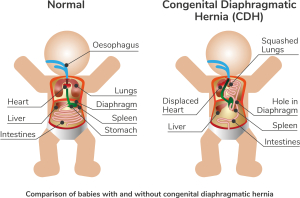Congenital Diaphragmatic Hernia
The diaphragm is the muscle which separates a baby's chest from their tummy, and is the main muscle that is used for breathing. Congenital Diaphragmatic Hernia (CDH) is a condition where the baby is born with a hole in the diaphragm. Because there is a hole in the diaphragm, the intestines, and sometimes other organs such as the stomach, spleen and liver, develop in the chest instead of in the abdomen. Most babies with CDH will undergo an operation to close the hole in their diaphragm, but unfortunately, about 1 in 5 are very ill, and die before they are able to undergo an operation.

Description of Diagram
Normally, a baby's heart and lungs sit within the chest, and the intestines, stomach, liver and spleen sit inside the abdomen. The chest is separated from the abdomen by a muscle called the diaphragm. In babies with congenital diaphragmatic hernia, there is a hole in the diaphragm, usually on the left-hand side, which means that instead of staying inside the abdomen, the intestines (and sometimes stomach, spleen and liver) move up into the chest. This means heart and lungs get squashed and displaced by the intestines being in the chest.
More information about congenital diaphragmatic hernia can be found on the websites below:
Southampton Children's Hospital
CDH UK is a charity supporting parents of children born with Congenital Diaphragmatic Hernia

